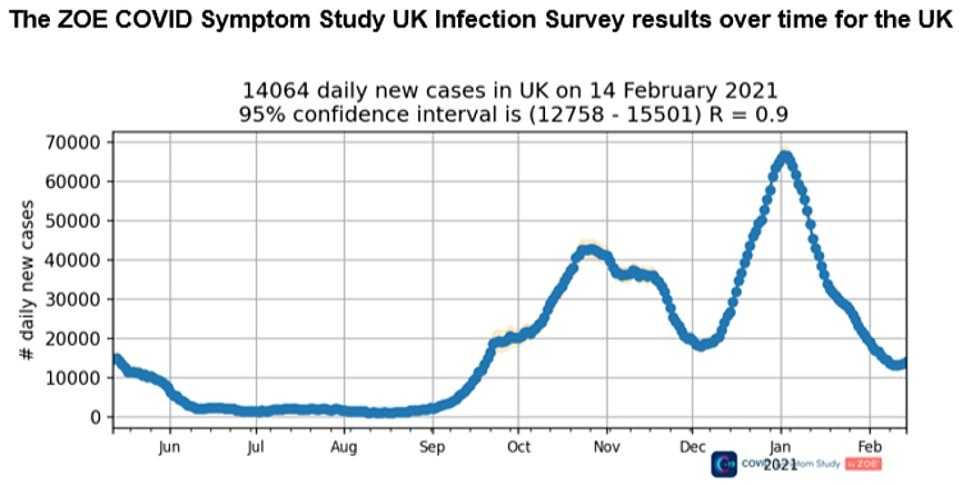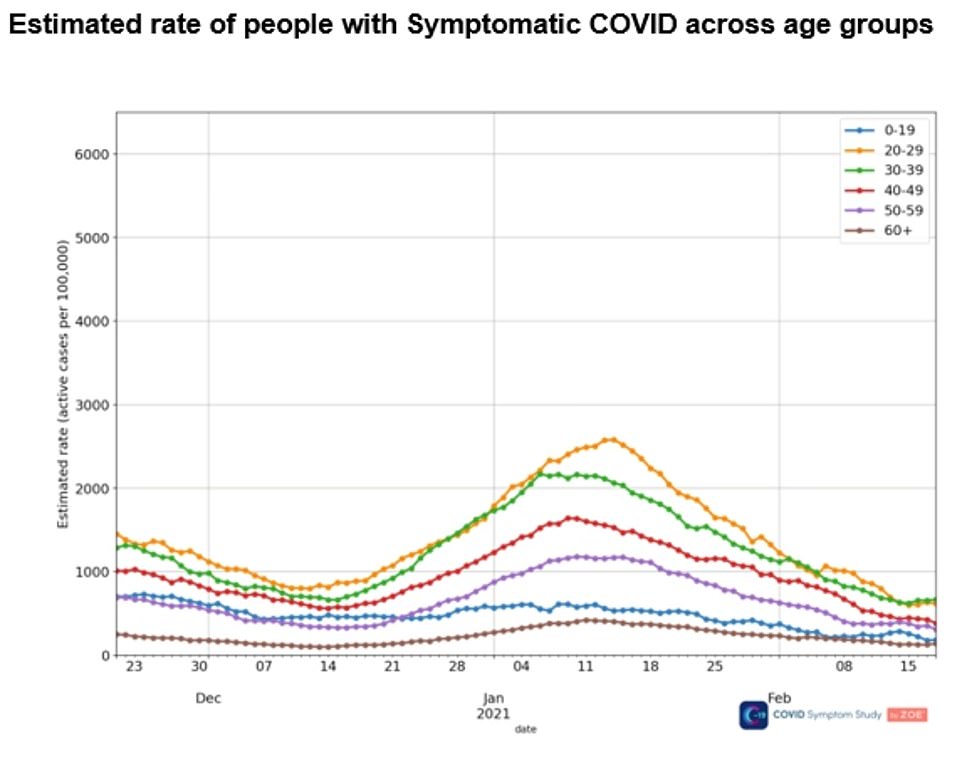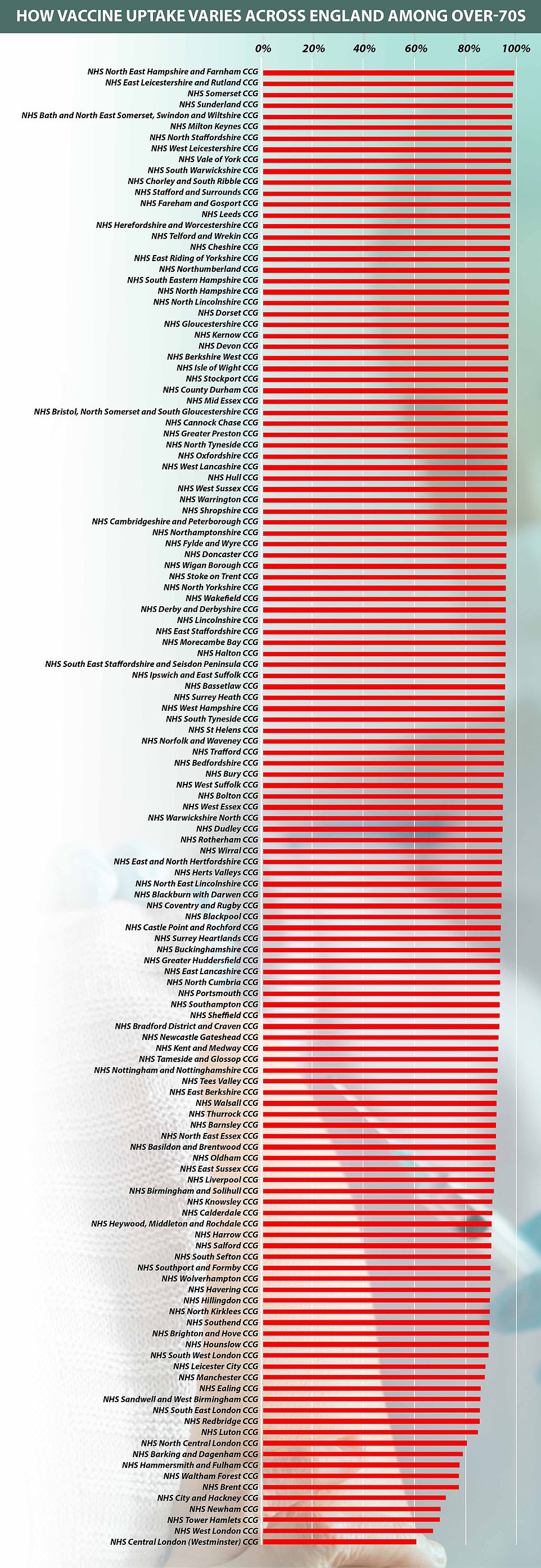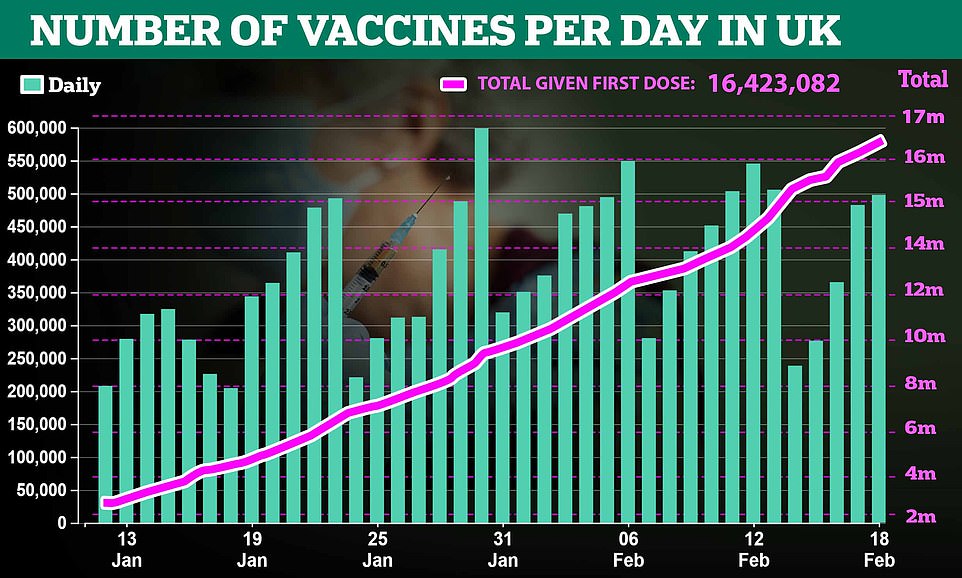England’s Covid vaccine postcode lottery was laid bare today after it emerged parts of London have jabbed just 60 per cent of over-70s – while almost every elderly person has had their first dose in one district in Hampshire.
The NHS England statistics, which go up to February 14, also show that some parts of the country have dished out nearly 300 times as many second doses as others.
The capital was hardest hit by the lottery overall, accounting for the worst 10 areas for uptake. Bottom of the pile was Westminster, in the city centre, where only 60.9 per cent of residents over 70 have had their first injection. West London was second, where 67.5 per cent in the same age group have been jabbed.
On the other hand, North East Hampshire and Farnham which had got 99.8 per cent of its over-70s their first doses, the highest level in the country. East Leicestershire and Rutland was second, at 99.3 per cent. Somerset and Sunderland have both also jabbed more than 99 per cent of over-70s with either Pfizer’s or Oxford’s vaccine.
It comes as a symptom-tracking app today predicted the nosedive in the country’s Covid cases has slowed, with symptomatic infections dropping five per cent to 14,064 new daily cases in the seven days to February 14 – the equivalent of 1 in 294 Britons having Covid. But this was still far below the levels in the darkest days of January when more than 69,000 daily cases were recorded.
The ZOE Covid-19 Symptom Study said there had been a slight increase in cases among 20 to 39-year-olds, but that they were still falling among over-60s who are most at risk of hospitalisation or death if they catch Covid.
It added the R rate – measuring the spread of the disease – may have risen to 1 in Yorkshire, the East Midlands and the North East as well as as well as Scotland, Wales and Northern Ireland, suggesting the second wave may have stopped shrinking in these areas.
The app relies on daily reports from more than a million Britons on whether they are feeling unwell, and whether they have tested positive for the virus. But it is only able to pick up infections that are symptomatic, and cannot detect those that don’t trigger warning signs – thought to be at least a third of all cases.
Health chiefs fear vaccine hesitancy among black, Asian and ethnic minority (BAME) groups is behind the poorer uptake in London’s culturally diverse boroughs. It follows reports of GP surgeries in London having to close early because not enough people have been turning up to get their injection.
Number 10 decided last month to delay the second dose for up to 12 weeks in an attempt to get the first injection to as many Brits as possible, which may partially explain the disparity.
The figures do not take into account health and social care staff or extremely clinically vulnerable younger people, such as those with terminal illnesses, who are both also at the top of the vaccine priority list. Instead, they look solely at over-70s, who are most at risk of dying from the illness.
Britain has already vaccinated more than 16million people and ministers have pledged to dish out jabs to all 32million in the top nine groups by April. With the Government taking a cautious approach to easing lockdown this time around, it is widely accepted that all of the nine top vulnerable groups will need to have had at least one dose of vaccine before curbs can be significantly eased.


The ZOE Covid-19 Symptom Study said the nosedive in coronavirus infections had slowed in the UK, dropping just five per cent to 14,064 symptomatic new infections a day in the week ending February 14

They suggested this change may be being driven by a slight rise in infections among those aged 20 to 39, but said cases were still falling in the over-60s, who are most at risk of death or serious illness if they catch the virus



WHICH AREAS HAVE GIVEN OUT THE MOST FIRST DOSES TO THE OVER-70S?
North East Hampshire and Farnham
99.8 per cent
East Leicestershire and Rutland
99.3 per cent
Somerset
99.3 per cent
Sunderland
99.1 per cent
Bath and North East Somerset, Swindon and Wiltshire
99.0 per cent
Milton Keynes
98.9 per cent
North Staffordshire
98.8 per cent
West Leicestershire
98.6 per cent
Vale of York
98.6 per cent
South Warwickshire
98.5 per cent
Advertisement WHICH AREAS HAVE GIVEN OUT THE LEAST FIRST DOSES TO THE OVER-70S?
North Central London
79.4 per cent
Barking and Dagenham
78.1 per cent
Hammersmith and Fulham
78.1 per cent
Waltham Forest
77.9 per cent
Brent
77.9 per cent
City and Hackney
72.6 per cent
Newham
70.5 per cent
Tower Hamlets
70.3 per cent
West London CCG
67.5 per cent
Central London (Westminster) CCG
60.9 per cent
Advertisement
The ZOE app found in the first week of February there were 14,818 new infections daily, only slightly above the levels recorded this week.
They estimated the areas with the highest infection rates were Lancashire, Blackpool and Blackburn with Darwen where 1 in 277 residents was thought to have the virus. They were followed by Greater Manchester, with 1 in 287 and the Liverpool City region with 1 in 337.
Professor Tim Spector, a top epidemiologist who leads the app, said that the fall in infections has begun to ‘plateau’ compared to the last six weeks.
‘This is mainly true in places like Scotland, Wales, and the Midlands compared to London and the East,’ he said. ‘It’s unclear why this is happening, although people relaxing their guard after vaccination or altering behaviour in the cold weather are possible.
‘But it’s encouraging that Covid-related hospital admissions are still falling and much lower than at the peak. With cases still falling in the at-risk age groups and the vaccination roll out continuing there is still reason to be hopeful – but we clearly can’t be complacent.’
The King’s College London epidemiologist also called on the NHS to expand its list of Covid symptoms – high temperature, continuous cough and loss of taste and smell – to ensure that as many cases are detected as possible.
At present, only those suffering the three key warning signs are encouraged to get a test. But mountains of research has shown the virus can trigger many other symptoms in the early stages, including fatigue, diarrhoea and a sore or white tongue.
‘We are pushing for the list to be expanded to help us pick up more cases and drive down the number of cases,’ he said. ‘It’s also important for any new variants that may cause different symptoms. For us, the message for the public is clear: If you’re feeling newly unwell, it could be Covid and you should get a test.’
The Department of Health announced another 497,257 vaccine doses were administered yesterday, taking the total number of people to be immunised to 16,423,082.
The NHS must reach 15.6million more people over the next four days – an average 502,481 per day – 32million Britons in the top nine groups by April.
Ministers are hunting for vulnerable Britons who have not yet come forward for their jab, warning that having large numbers of unprotected people could delay the easing of lockdown.
It comes after the NHS today unveiled a ‘blueprint’ to improve coronavirus vaccine uptake among ethnic minority groups.
Local faith and community leaders will team up with doctors to host online virtual events where they will answer questions and address concerns people have about the jabs.
They will also distribute leaflets in 20 different languages — including Arabic, Punjabi and Hindi — to reach those who do not speak English fluently or can’t be targeted through traditional methods.
People want ‘normal way of life’ back after getting Covid jabs: Government adviser says it’s ‘not plausible’ to expect Britons to comply with major curbs once they’ve had both doses
The public will not accept having to comply with draconian coronavirus restrictions once they have been vaccinated, a Government adviser warned today.
Professor Sir John Bell, who is a member of the Government’s vaccine taskforce, claimed it is ‘not plausible’ to expect people to abide by major curbs, such as a ban on attending football matches, if they have received both doses.
Speaking at the Commons Science and Technology Committee today, he told MPs that people want to get back to a ‘relatively normal way of life’ and steps need to be taken to allow that.
He said: ‘It’s not plausible to imagine a world where we vaccinate the whole country and everybody believes they are still in a place that we were in six months ago, it’s just not reasonable
‘I think we are going to have to allow people to adapt their behaviours appropriately if they have actually had the vaccine.’
Oxford University’s regius professor of medicine added: ‘It’s better to plan for that than to assume you can hold back the water with a dam, because you won’t be able to.
‘People will feel that they would like to get back to a relatively normal way of life and I suspect we are going to have to get used to that.’
Sir John warned that further mutations in the virus are likely in response to the rollout of the vaccination programme.
So far most of the variants have been due to the virus evolving to be more effective in humans, having only recently crossed species, but that will change as coronavirus comes under pressure from the vaccines.
‘Most of the variants we have seen so far represent that kind of adaptation to a new species – it’s a bit like moving into a new apartment, you are shuffling the sofa around and making sure the TV is in the right place,’ he said.
‘What we will see between now and the end of the year is a number of variants which are driven by immunological selection, largely by the vaccines, and that will add another layer of complexity.’
Advertisement
Number 10’s Counter Disinformation Unit will ramp up its efforts and work with social media companies to tackle anti-vaxx misinformation online. Bogus claims that the jabs contain animal products or interfere with fertility have been widely distributed on platforms include WhatsApp, YouTube and Facebook.
BAME people who have already received their first dose could also be recruited to give testimonies and encourage friends and family to get the vaccine.
Figures have shown that a significant number health and social care workers from black, Asian and ethnic minority (BAME) backgrounds have been reluctant to get the jab.
Research this week suggested white NHS staff are almost twice as likely as black medics to get the Covid vaccine.
A lack of trust in Government is thought to be one of the main reasons behind their hesitancy, numerous surveys have suggested. Minorities face a higher risk of having a severe bout of Covid or dying, several studies have shown.
Meanwhile, No10 has been urged to expand the rollout of Covid vaccines to include all over-50s as soon as there are enough supplies to avoid bottlenecks as the country moves through the priority list.
NHS bosses say local health teams can make their own way down the list of nine priority groups, so long as they have attempted to reach everyone in a group before moving on.
But areas that are further ahead in vaccinating their elderly populations are more quickly making their way through younger people, while willing people of the same age are left waiting longer in areas that are struggling more to reach older residents.
Critics suggest that opening up the scheme so anyone in a priority group can get a vaccine as soon as they want one could avoid low uptake in certain groups holding back others.
Dr Simon Clarke, a microbiologist at the University of Reading, said ‘it would make sense’ to roll out jabs to people in their 50s and 60s as soon as supplies allow.
Think-tanks said officials needed to be more ambitious about the speed and not get stuck on particulars, saying it was ‘false economy’ to slow down some groups or clinics to help others catch up.
Minister will have to start dishing out second doses within weeks, making it essential to keep up the pace and get as many first jabs done before that begins to eat into supplies.
At the current pace of 434,301 people per day, it will take until March 26 to give a first dose to 32million people.
Some over-60s have already began being given the jab in areas across the country, with areas of Manchester and London handing out doses to the next age bracket.
Wales began inviting over-50s, while Northern Ireland started offering appointments to over-65s in January.
Scotland’s First Minister Nicola Sturgeon yesterday said 53 per cent of 65-69 year-olds have already received their first dose of vaccine.
The Adam Smith Institute think-tank urged areas of the country already ahead of the curve to open up the programme to over-50s now.
A spokesperson told MailOnline: ‘Each person jabbed represents a life that won’t be lost to this terrible disease. We should be trying to ensure jabs reach as many people as possible as quickly as possible. If some areas have steamed ahead they should to continue apace, opening up to the over-50s and other cohorts.
‘Areas that fall behind should be looking at best practice at home and abroad to increase the vaccination rate, including ringing down lists, using online bookings and social media to reach out if spare doses are available towards the end of the day, targeted outreach to hard to reach demographics.
‘Slowing down some parts in the hope others speed up is a false economy and it’s one with a high cost in terms of lives potentially saved and taxpayers borrowing to keep the companies going while the economy is closed.’
And experts have urged No10 to be more ambitious in the roll-out’s second phase in order to open up the economy.
Dr Simon Clarke said: ‘I would say it’s vital that, as long as the bottlenecks in other areas are not due to lack of vaccine doses, it would make sense to roll out vaccination to over-50s.
‘There is no sense in not vaccinating people in one area just because there at logistical problems in others. But it’s vital that people who may be higher up the priority list because of need are not denied a vaccine because it’s been sent elsewhere.’
Source link : https://www.dailymail.co.uk/news/article-9274927/Englands-Covid-vaccine-postcode-lottery-Parts-London-jabbed-60-60s.html











